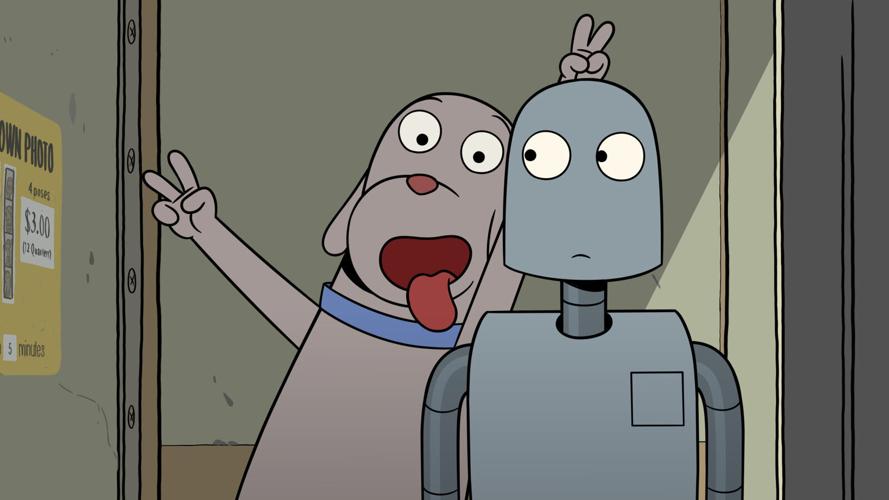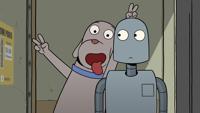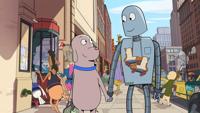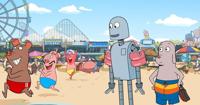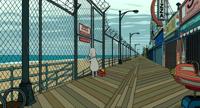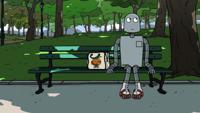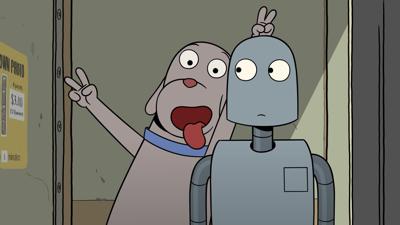This is the fourth film from Spanish filmmaker, Pablo Berger. His three previous features were noticeably aimed at adults. This one is his first where young children can watch, but it could still arguably be for adults too, although the narrative here is really simplistic. Yet, there could be some who might argue that the narrative is actually a bit too convoluted. As I was watching it, the narrative got to a point where it was mostly repetitive and dragging. However, it built to an ending that was effective and emotionally moving. I felt as though it was making a statement about relationships and how some don't last forever. Some people can be friends or even more than that, having a strong bond or connection. For whatever reason, they can split apart. They can move forward with other bonds or connections that are just as strong and sometimes it's best or beneficial not to look back or go back. I felt that the film was making a statement about perseverance and still moving forward, despite the fact that you might lose people you care about along the way, and that there are always new people to meet and with whom you can connect.
However, I was listening to the Critically Acclaimed podcast #292, hosted by William Bibbiani and Whitney Seibold, in which they discussed this film. Bibbiani brought up a point that I hadn't considered but spoke to my initial feelings about the film. Addressing that point requires bringing up some plot that could be considered spoiler but are necessary. It should be noted that this film was nominated for Best Animated Feature at the 96th Academy Awards. It lost at that award show. It's also in the high 90's on Rotten Tomatoes, so it's beloved by most critics and otherwise. Bibbiani's counterpoint is one that spoke to me though.

The narrative is about an anthropomorphic dog named "Dog." He lives in New York City in the 1980's. He's apparently very lonely. He has no friends, no companions and apparently no family to share his time. One day, he sees an ad on TV for a robot that could be his companion. He orders the robot, assembles it and it's simply called "Robot." Dog and Robot spend all-day and all-night together. They eat, sleep, play, walk and even hold hands together. They are the best of friends. Some might say they're even more, but one day they go to the beach, apparently on the last day of beach season. On that day, Robot malfunctions and can't move. For some reason, Dog can't move Robot or drag Robot off the beach. Dog goes home to the city to find tools to fix Robot, but when he gets back, the beach is closed. Literally, there's a giant fence that's locked, which prevents Dog from getting to Robot. Dog tries to get to the beach in a couple of ways, but then decides to wait nearly a year until beach season begins again.
The majority of the film is basically Dog waiting until the beach opens, which is nearly a year. Meanwhile, Robot simply has to lay on the beach paralyzed from the neck down and the only thing it can do is sleep. While it does, Robot has dreams or nightmares. We see those dreams, which are ways that Robot finds a way to get off the beach and go back to the city to be with Dog. While Robot dreams, Dog tries to make new friends or companions. None work out.

Bibbiani's argument is that Dog gives up on trying to get to Robot way too easily. Robot is too heavy for Dog to drag or lift off the beach. All this happens at night, so there's no one around to help him. Yet, Dog could have disassembled Robot and carried him off the beach in pieces, but he doesn't think to do that apparently. Over the course of the year, Dog could've devised a way to rescue Robot because we see others get to Robot, but not Dog. Dog could've gotten to Robot in the same way as those others did. The fact that Dog gave up so easily makes the Dog a very dis-likeable character. The idea that one would give up and leave a paralyzed friend on a beach for nearly a year without doing everything possible to rescue that friend was too much of a hurdle for Bibbiani. One could argue it's a robot. Who cares if it's paralyzed and stuck alone for a year? However, the film wants us to care about the robot, so dismissing it is antithetical to the film's overall message. It was problematic for me, but I suspended my disbelief because it seemed like the film was building to another point and used this ridiculous and cruel conceit as a way of separating the characters. The fence that blocks off the beach is one that feels incredulous, too incredulous, like something out of BoJack Horseman (2014) of which the animation here reminded me.
Spoiler alert! Spoiler alert! Spoiler alert!

Yet, even if you could get over that hurdle of Dog giving up and leaving Robot paralyzed on the beach for nearly year, Bibbiani still disliked the ending of this film. That ending is that Robot is able to get off the beach and get repaired. Another animal named Rascal is able to repair Robot. Rascal befriends Robot and the two of them spend a lot of time together. When Robot sees Dog with another robot who is his new friend, Robot decides not to tell Dog that he's back. He decides to let Dog go his separate way.
Bibbiani vehemently disagreed with this ending because it suggests that a person can't have multiple friends. I never considered that interpretation, which in reality would make it a film that is indeed about monogamy, or having rigidly exclusive relationships among friends, which isn't a good message. A person should be okay with having multiple friends or having multiple relationships with people without feeling like your sacrificing or hurting anyone else by having other people in your life.

Not Rated but for general audiences.
Running Time: 1 hr. and 43 mins.
Available on VOD and on DVD on October 8.


